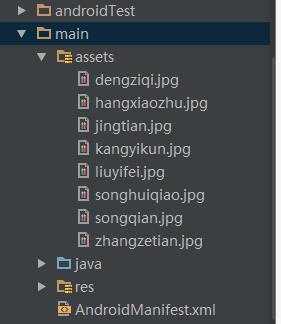android:Android中用文件初始化sqlite数据库
Posted brave-sailor
tags:
篇首语:本文由小常识网(cha138.com)小编为大家整理,主要介绍了android:Android中用文件初始化sqlite数据库相关的知识,希望对你有一定的参考价值。
很多时候在应用安装初始化时,需要创建本地数据库,同时为数据库添加数据,之后再从数据库中读取数据。
这里有2个思路
1.先在本地创建一个能支持android使用的sqlite数据库文件,启动时,用现成的sqlite的二进制文件进行直接copy到Android系统的数据库路径
2.可以考虑在第一次启动时,执行数据库初始化的sql文件.
1.在本地准备android能使用的sqlite数据库文件
使用sqlite数据库管理工具,看个人爱好(SQLite Database Browser ,Navicat Premium,)
打开数据库,创建"android_metadata"数据表
- CREATE TABLE "android_metadata" ("_id" INTEGER PRIMARY KEY AUTOINCREMENT,"locale" TEXT DEFAULT \'en_US\');//创建表
- INSERT INTO "android_metadata" VALUES (1,\'en_US\');//插入值
创建其他应用需要的表..此处省略.
2.复制文件到应用中.
把第一步创建的数据库文件复制到应用中的assets文件夹, asserts文件夹的路径如下:

然后创建DateBaseHelper extends SQLiteOpenHelper的类文件.
代码如下:
- public class DataBaseHelper extends SQLiteOpenHelper {
- //The Android\'s default system path of your application database.
- private static String DB_PATH = "/data/data/YOUR_PACKAGE/databases/";
- private static String DB_NAME = "myDBName";
- private SQLiteDatabase myDataBase;
- private final Context myContext;
- /**
- * Constructor
- * Takes and keeps a reference of the passed context in order to access to the application assets and resources.
- * @param context
- */
- public DataBaseHelper(Context context) {
- super(context, DB_NAME, null, 1);
- this.myContext = context;
- }
- /**
- * Creates a empty database on the system and rewrites it with your own database.
- * */
- public void createDataBase()throws IOException {
- boolean dbExist = checkDataBase();
- if (dbExist) {
- //do nothing - database already exist
- } else {
- //By calling this method and empty database will be created into the default system path
- //of your application so we are gonna be able to overwrite that database with our database.
- this.getReadableDatabase();
- try {
- copyDataBase();
- } catch (IOException e) {
- throw new Error("Error copying database");
- }
- }
- }
- /**
- * Check if the database already exist to avoid re-copying the file each time you open the application.
- * @return true if it exists, false if it doesn\'t
- */
- private boolean checkDataBase() {
- SQLiteDatabase checkDB = null;
- try {
- String myPath = DB_PATH + DB_NAME;
- checkDB = SQLiteDatabase.openDatabase(myPath, null, SQLiteDatabase.OPEN_READONLY);
- } catch (SQLiteException e) {
- //database does\'t exist yet.
- }
- if (checkDB != null) {
- checkDB.close();
- }
- return checkDB != null ? true : false;
- }
- /**
- * Copies your database from your local assets-folder to the just created empty database in the
- * system folder, from where it can be accessed and handled.
- * This is done by transfering bytestream.
- * */
- private void copyDataBase()throws IOException {
- //Open your local db as the input stream
- InputStream myInput = myContext.getAssets().open(DB_NAME);
- // Path to the just created empty db
- String outFileName = DB_PATH + DB_NAME;
- //Open the empty db as the output stream
- OutputStream myOutput = new FileOutputStream(outFileName);
- //transfer bytes from the inputfile to the outputfile
- byte[]buffer = new byte[1024];
- int length;
- while ((length = myInput.read(buffer)) > 0) {
- myOutput.write(buffer, 0, length);
- }
- //Close the streams
- myOutput.flush();
- myOutput.close();
- myInput.close();
- }
- public void openDataBase()throws SQLException {
- //Open the database
- String myPath = DB_PATH + DB_NAME;
- myDataBase = SQLiteDatabase.openDatabase(myPath, null, SQLiteDatabase.OPEN_READONLY);
- }
- @Override
- public synchronized void close() {
- if (myDataBase != null)
- myDataBase.close();
- super.close();
- }
- @Override
- public void onCreate(SQLiteDatabase db) {}
- @Override
- public void onUpgrade(SQLiteDatabase db, int oldVersion, int newVersion) {}
- // Add your public helper methods to access and get content from the database.
- // You could return cursors by doing "return myDataBase.query(....)" so it\'d be easy
- // to you to create adapters for your views.
- }
3.现在我们可以创建DateBaseHelper的实现操作了.
createDataBase() //创建
openDataBase()//打开只读数据库
记得要更改"YOUR_PACKAGE"为你的应用的包名
如:com.examplename.myapp
大概代码如下:
- ...
- DataBaseHelper myDbHelper = new DataBaseHelper();
- myDbHelper = new DataBaseHelper(this);
- try {
- myDbHelper.createDataBase();
- } catch (IOException ioe) {
- throw new Error("Unable to create database");
- }
- try {
- myDbHelper.openDataBase();
- } catch (SQLException sqle) {
- throw sqle;
- }
- ...
以上是关于android:Android中用文件初始化sqlite数据库的主要内容,如果未能解决你的问题,请参考以下文章
如何在Android设备中用NDK编译SQLite并且对SQLite进行操作
Android中用ANT打包如何将内容复制到AndroidManifest文件中